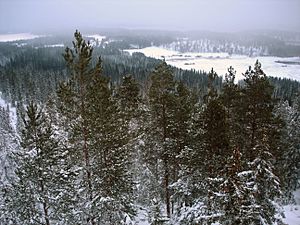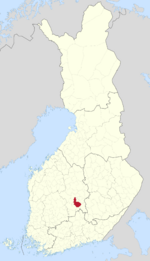Korpilahti facts for kids
Quick facts for kids
Korpilahti
|
||
|---|---|---|
|
Former municipality
|
||
| Korpilahden kunta | ||

Landscape of Korpilahti seen from the top of mount Oravivuori
|
||
|
||

Location of Korpilahti in Finland
|
||
| Country | Finland | |
| Province | Western Finland Province | |
| Region | Central Finland | |
| Established | 1861 | |
| Merged into Jyväskylä | 2009 | |
| Seat | Korpilahden kirkonkylä | |
| Area
794.62
|
||
| • Land | 614.58 km2 (237.29 sq mi) | |
| • Water | 177.44 km2 (68.51 sq mi) | |
| Population
(2008-12-31)
|
||
| • Total | 5,061 | |
| • Density | 8.23/km2 (21.3/sq mi) | |
Korpilahti was a small town in Finland. It is no longer a separate town. On January 1, 2009, Korpilahti joined with a bigger city called Jyväskylä. Another nearby area, Jyväskylän maalaiskunta, also joined Jyväskylä at the same time.
Korpilahti was located in the western part of Finland. It was part of the Central Finland region. Many people from other places visited Korpilahti in the summer. About 2,000 summer cottages were there for visitors. This meant about 4,500 people would be in Korpilahti during the summer months.
The main language spoken in Korpilahti was Finnish. There was also an older Swedish name for the area, "Korpilax," but it is not used anymore. The local government was mostly led by the Centre Party.
Korpilahti is well-known for its beautiful nature. It has many large hills and about 200 lakes. Part of Päijänne, which is the second largest lake in Finland, is also in the Korpilahti area.
Geography
Korpilahti was surrounded by several other towns. These included Muurame, Toivakka, Joutsa, and Jämsä. The borders changed a few times over the years. For example, it used to border Koskenpää and Leivonmäki.
Villages in Korpilahti
Many smaller communities, or villages, made up the area of Korpilahti. Some of these villages include:
- Honkala
- Juokslahti
- Kähö
- Korpilahti
- Moiskala
- Muurame
- Muuratjärvi
- Nuorlahti
- Oittila
- Pajulahti
- Putkilahti
- Raidanlahti
- Riihijärvi (Moksi)
- Ruotsula
- Rutalahti
- Sammallahti
- Särkijoki
- Säyrylä
- Tervala
- Veijo
- Vitikkala
- Yijälä
History
Korpilahti was first mentioned in old records in 1596. Back then, it was called Kårpilaxiby. It was part of a larger church area known as Jämsä. Korpilahti became its own separate church area in 1861.
Over time, some parts of Korpilahti became their own towns. For example, Muurame became a separate town in 1921. Later, Säynätsalo also separated from Muurame in 1924. Finally, in 2009, Korpilahti joined with Jyväskylä.
Vaaruvuori Hill
There was a plan to build a special power plant on Vaaruvuori hill. This plant would have used water from Päijänne lake to make electricity. It was called a pumped-storage hydroelectricity plant. However, people who cared about the environment did not want the plant built. Because of their efforts, the project was stopped.
See also
 In Spanish: Korpilahti para niños
In Spanish: Korpilahti para niños


